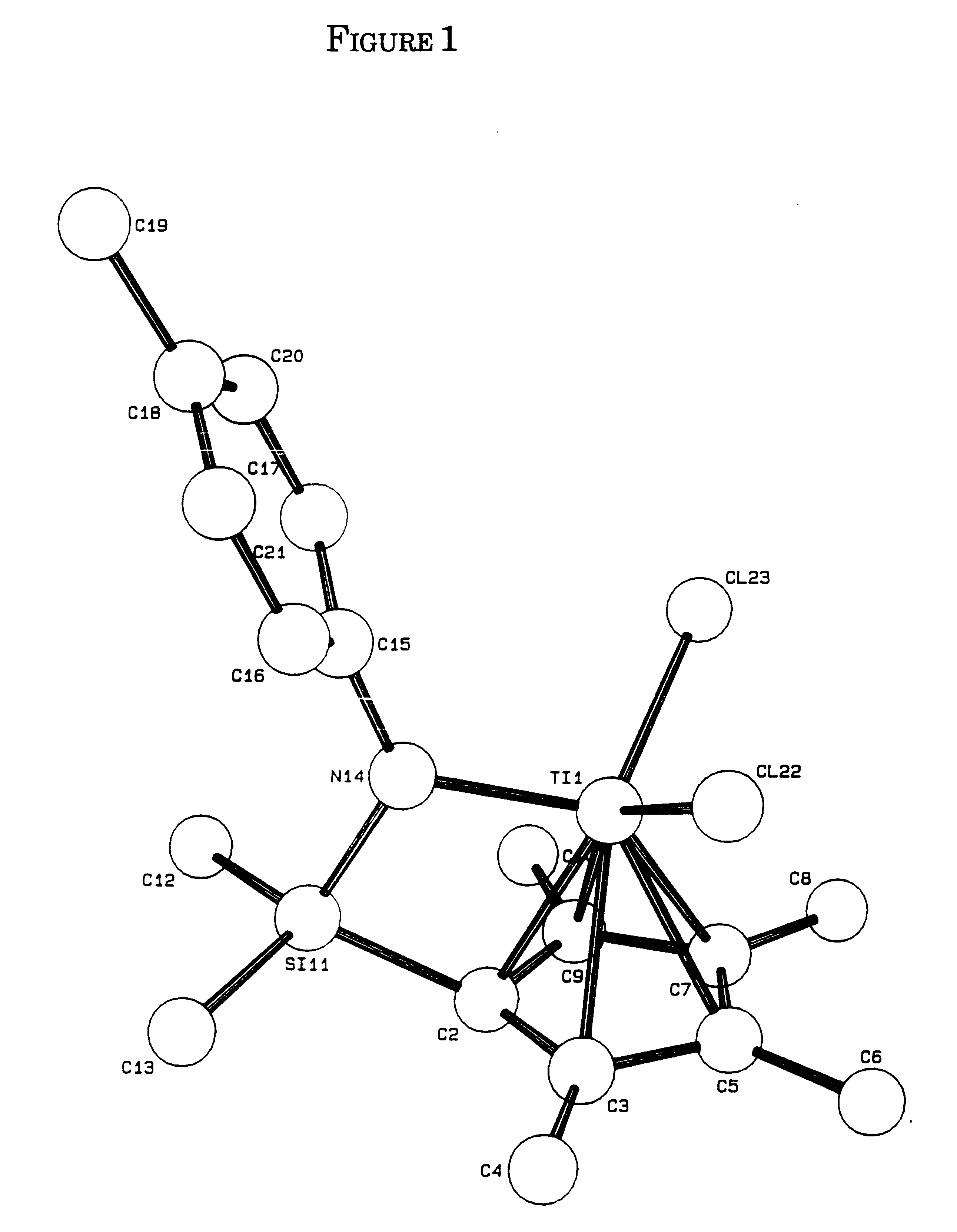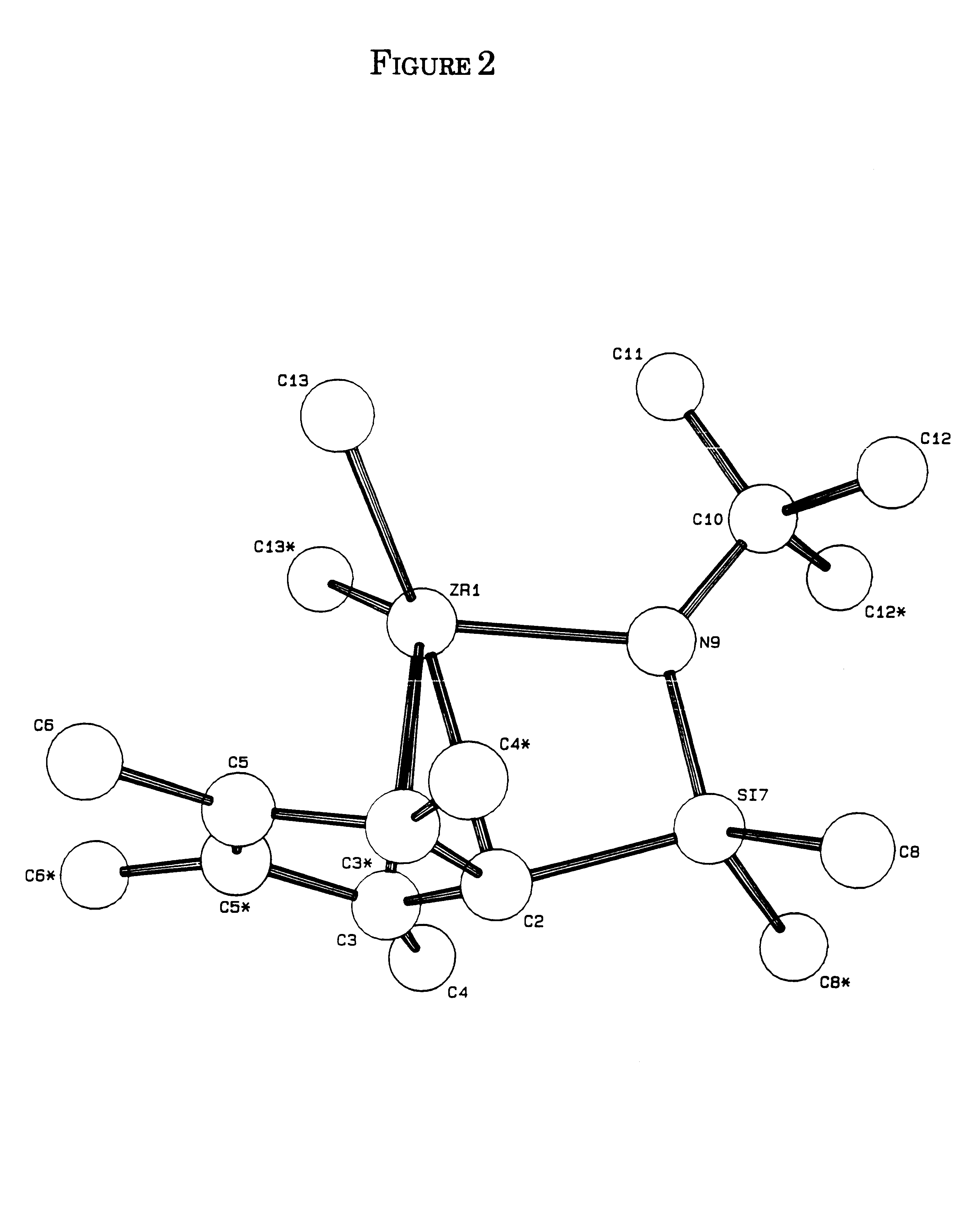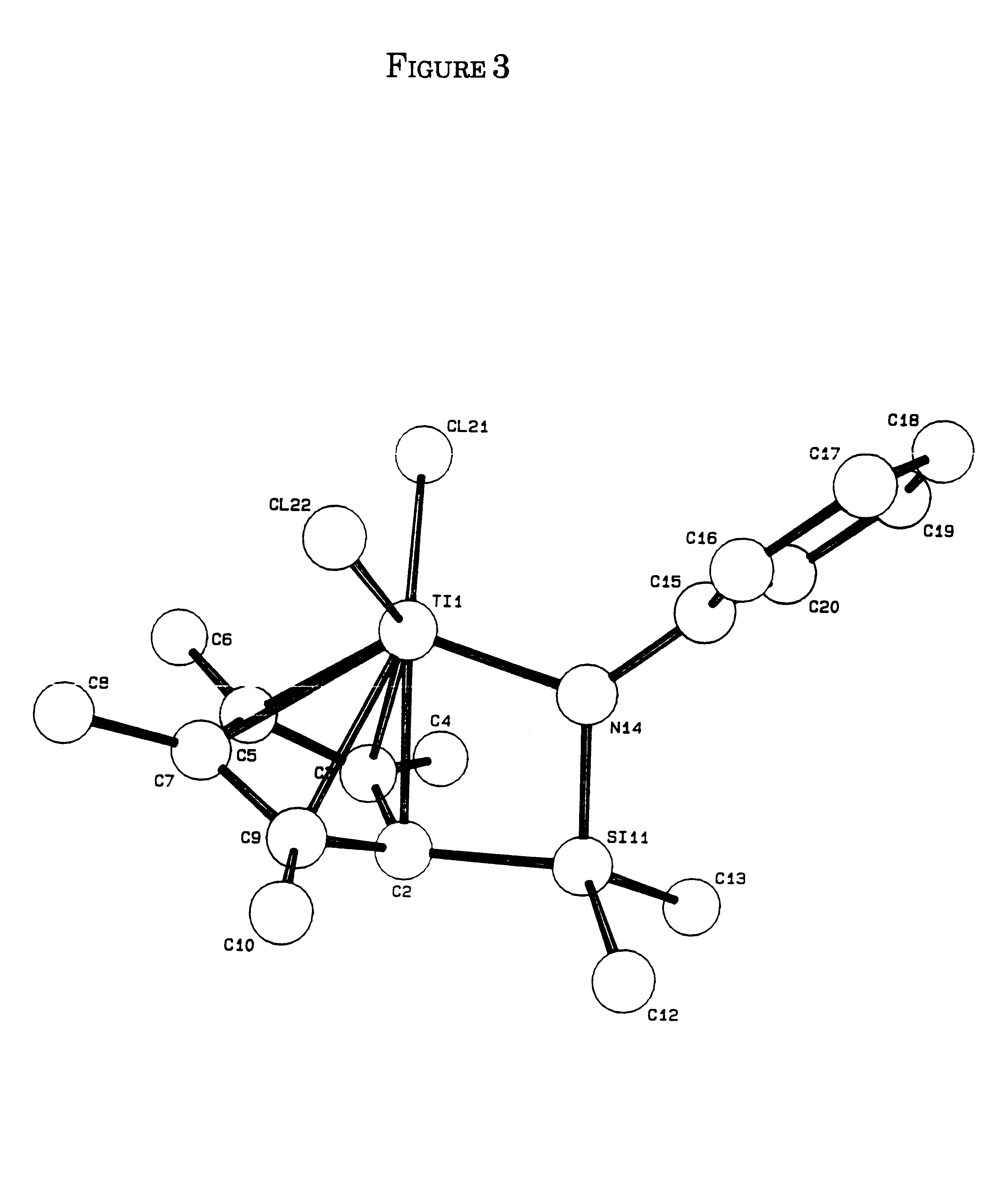Supported constrained geometry olefin polymerization catalysts
a polymerization catalyst and constrained geometry technology, applied in catalyst activation/preparation, group 3/13 element organic compounds, group 5/15 element organic compounds, etc., can solve the problems of low molecular weight polymerization, inability to achieve high activity of previously known addition polymerization catalysts, and polymerization of numerous monomers
- Summary
- Abstract
- Description
- Claims
- Application Information
AI Technical Summary
Problems solved by technology
Method used
Image
Examples
example 1
Preparation of
(Tert-butylamido)dimethyl(tetramethyl-η5-cyclopentadienyl)silane zirconium dichloride
To 0.443 g (1.90 mmol) ZrCl4 in a flask was added 8 mL diethyl ether, then 15 mL tetrahydrofuran (THF). To the resulting slurry was slowly added a solution of 0.500 g (1.90 tool) dilithium (tert-butyl-amido)dimethyl(tetramethylcyclopentadienyl)silane in 15% mL THF. The resulting yellow solution was stirred for several days. The solvent was removed to give a gummy residue, which was extracted with 5 / 1 (volume) diethyl ether / pentane and filtered from a white solid. The solvent was removed from the yellow filtrate to give a light-yellow powder. Recrystallization from ether / pentane (5 / 1) yielded the product (C5Me4(Me2Si—N-tert-Bu)ZrCl2) as an off-white crystalline solid. The yield was 0.2207 g (28.2%). Identification was made by 13C and 1H NMR.
Polymerization
A. Five mL of a 1.009 M solution of methyl aluminoxane (MAO) in toluene was added to a shot tank containing 25 mL of 4-methyl-1-penten...
example 2
Preparation of
(Tert-butylamido)dimethyl(tetramethyl-η5-cyclopentadienyl)silanetitanium dichloride
Preparation 1(Chloro)(dimethyl)(tetramethylcyclopentadi-2,4-enyl)silane
To a solution of 21.5 g (167 mmol) dimethyldichlorosilane in 150 mL THF cooled to −40° C. was slowly added a solution of 8.00 g (55.6 mmol) sodium 1,2,3,4-tetramethylcyclopentadienide in 80 mL THF. The reaction mixture was allowed to warm to room temperature and was stirred overnight. The solvent was removed, the residue was extracted with pentane and filtered. The pentane was removed under reduced pressure to give the product as a light-yellow oil. The yield was 10.50 g (88.0%). 1H NMR (C6D6) δ 2.89 (s, 1H), 1.91 (s, 6H), 1.71 (s, 6H), 0.14 (s, 6H); 13C NMR (C6D6) δ 137.8, 131.5, 56.6, 14.6, 11.4, 0.81.(Tert-butylamino)(dimethyl)(tetramethylcyclopentadi-2,4-enyl)silane
A solution of 11.07 g (151 mmol) t-butyl amine in 20 mL THF was added during 5 minutes to a solution of 13.00 g (60.5 mmol) (chloro)(dimethyl)(tetramet...
preparation 2
In a drybox, 4.0 mL of 2.0 M isopropylmagnesium chloride in diethyl ether was syringed into a 100 mL flask. The ether was removed under reduced pressure to leave a colorless oil. 20 mL of a 4:1 (by volume toluene:THF mixture was added followed by 0.97 g of (tert-butylamino)dimethyl(tetramethylcyclopentadienyl)silane. The solution was heated to reflux. After 8-10 hours, a white precipitate began to form. After refluxing for a total of 27 hours, the solution was cooled and the volatile materials were removed under reduced pressure. The white solid residue was slurried in pentane and filtered to leave a white powder (1.23 g, 62% yield) of Me4C5SiMe2N-t-BuMg2Cl2(THF)2.
In the drybox, 0.50 g of TiCl3(THF)3 was suspended in 10 mL of THF. 0.69 g of solid Me4C5SiMe2N-t-BuMg2Cl2(THF)2 was added, resulting in a color change from pale blue to deep purple. After 15 minutes, 0.35 g of AgCl was added to the solution. The color immediately began to lighten to a pale green-yellow. After 1½ hours, th...
PUM
| Property | Measurement | Unit |
|---|---|---|
| molar ratio | aaaaa | aaaaa |
| catalytic properties | aaaaa | aaaaa |
| molecular weight | aaaaa | aaaaa |
Abstract
Description
Claims
Application Information
 Login to view more
Login to view more - R&D Engineer
- R&D Manager
- IP Professional
- Industry Leading Data Capabilities
- Powerful AI technology
- Patent DNA Extraction
Browse by: Latest US Patents, China's latest patents, Technical Efficacy Thesaurus, Application Domain, Technology Topic.
© 2024 PatSnap. All rights reserved.Legal|Privacy policy|Modern Slavery Act Transparency Statement|Sitemap



